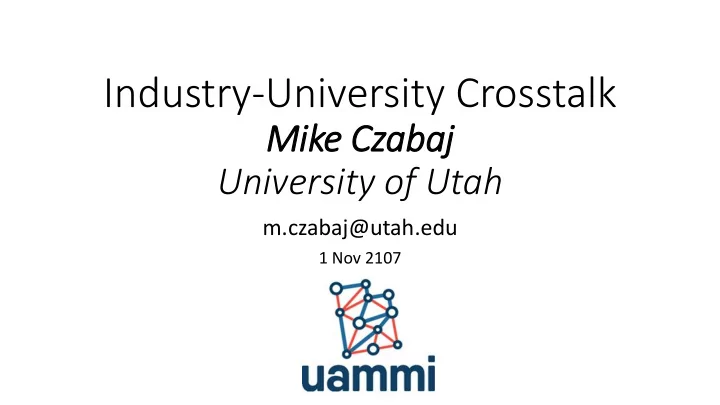

Industry-University Crosstalk Mike Czabaj University of Utah m.czabaj@utah.edu 1 Nov 2107
My background • Graduate work: high-temperature fracture of polyimide-matrix composites, and damage tolerance of sandwich composites • 4 years as a Materials Research Engineer at NASA Langley • 3 years as a Mechanical Engineering Assistant Professor at the U • 2016 Faculty Fellow at the Air Force Research Lab (AFRL/RXCC) • Chair, ASTM Committee D30-06 on Interlaminar Properties Research focus: Experimental and numerical fracture mechanics of fiber reinforced composites
Utah Composites Laboratory ry • Co-directed by Dan Adams and Mike Czabaj • Managed by Jeff Kessler • 11 Ph.Ds., 12 M.S., and 11 URAs • Facilities : Materials and structures testing lab Non-destructive evaluation and imaging lab Composites fabrication lab Our research philosophy: Use best available experimental and computational tools to understand how composites deform, damage, and fail across broad range of length and time scales, as well as, various operating conditions.
Spectrum of our research efforts Characterization of ply-level Structural testing damage initiation and evolution Micromechanics Testing and analysis of scarf repairs Basic Applied science engineering Modeling of Design and standardization Characterization of progressive damage of characterization tests microscale failure
Experimental facilities • Materials and structural testing lab • Uniaxial and tension-torsion servo-hydraulic load frames • Electromechanical and electrodynamic load frames • Instron Dynatup and custom drop towers • Non-destructive evaluation and imaging lab • X-ray computed tomography (Varian, GE) Merrill Engineering Building • Digital Image Correlation (2D and 3D, macro, micro) • Sonix Ultrasonic Inspection System • Acoustic emission sensors • Composites fabrication • Autoclave, hot press, curing ovens • LulzBot 3D printers, X-winder 8ft 4-axis winder • Miscellaneous Nanofab Facility • Laser vibrometer, shaker table, hi-speed cameras, accelerometers, Optical microscopy, strain conditioning and acquisition, suite of testing fixtures SEM, TEM, FIB, EBSD
Characterization of fracture in in PMCs and CMCs at t th the mic icroscale Ceramic matrix composite Polymer matrix composite
Damage evolu lution in in bia iaxia ially lo loaded composites at t cry ryo-temperatures NASA SLS core Numerical and experimental results Progressive damage modeling stage NASA.gov Permeation of the cryogen Biaxial cruciform geometry X-rays
Testi ting and analy lysis of composit ite scarf repairs s, t www.airforce-technology.com J Ic w J IIc v Experimental and numerical building block approach
Our r needs from th the Utah composit ites in industry try • Tours of your composites facilities (~120 students in Mechanics of Composites class each year) • Internships and job opportunities for our students (B.S., M.S., Ph.D) • Non-essential hardware and raw materials (e.g. expired pre-preg, adhesives, lab supplies) • Sponsorship of composites-related senior design projects ($$, raw materials, expertise)
Recommend
More recommend